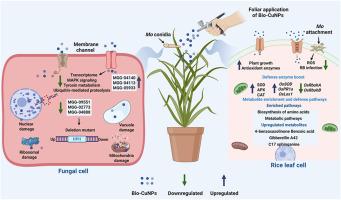先进的双功能纳米疗法通过靶向真菌抑制和水稻免疫增强,对稻瘟病菌进行多层防御
IF 10.2
1区 医学
Q1 ENGINEERING, BIOMEDICAL
引用次数: 0
摘要
稻瘟病是由稻瘟病菌(Magnaporthe oryzae, Mo)引起的稻瘟病,严重威胁着全球水稻生产。在本研究中,利用解淀粉芽孢杆菌Q1在细胞外合成了生物源铜纳米颗粒(bio-CuNPs),并鉴定了其抗真菌活性和植物防御诱导作用。Bio-CuNPs (16-62 nm,平均37 nm)通过显著抑制Mo菌丝生长、分生孢子萌发和附着胞形成(呈剂量依赖性)表现出有效的抗真菌作用。显微镜观察显示,生物cunps破坏了Mo菌丝的完整性,引起细胞内渗漏,并诱导DNA损伤。转录组学分析鉴定了CuNP暴露后Mo的关键调控基因,其中细胞壁生物合成(MoCHS-A、MoCHS-B、MoCHS-C和MoCHS-D)和膜运输途径(MoMFS-1、MoMFS-2和MoMSC-2)受到关键干扰。这些基因的缺失突变体表现出对生物cunps的高度敏感性,表明这些基因对帮助Mo抵抗生物cunps的抗真菌作用至关重要。然而,生物cunps破坏了它们在Mo中的功能,证实了这些基因是抑制Mo生长和毒力的分子靶点之一。植物试验表明,叶面施用生物cunp可降低病害严重程度,促进植物生长,激活抗氧化酶,同时抑制氧化应激源(即超氧化物根和过氧化氢)。代谢组学分析揭示了防御相关途径的显著改变,包括苯丙素和氨基酸代谢。此外,CuNPs增加水杨酸和茉莉酸甲酯水平,随后上调防御基因表达。细胞毒性试验显示,在有效浓度下,生物cunps对AML12细胞无毒,突出了它们作为可持续稻瘟病管理的生态友好策略的潜力。本文章由计算机程序翻译,如有差异,请以英文原文为准。

Advanced bifunctional nanotherapeutics display multi-tiered defense against Magnaporthe oryzae through targeted fungal inhibition and rice immunity enhancement
Rice blast disease, caused by Magnaporthe oryzae (Mo), severely threatens global rice production. In this study, biogenic copper nanoparticles (bio-CuNPs) were synthesized extracellularly using Bacillus amyloliquefaciens Q1 and characterized for antifungal activity and plant defense induction. Bio-CuNPs (16–62 nm, average 37 nm) exhibited potent antifungal effects by significantly inhibiting Mo mycelial growth, conidial germination, and appressorium formation in a dose-dependent manner. Microscopic observations revealed that bio-CuNPs disrupted Mo hyphal integrity, caused intracellular leakage, and induced DNA damage. Transcriptomic profiling identified key regulatory genes in Mo upon CuNP exposure, with key disruptions in cell wall biosynthesis (MoCHS-A, MoCHS-B, MoCHS-C, and MoCHS-D) and membrane transport pathways (MoMFS-1 MoMFS-2, and MoMSC-2). Deletion mutants for these genes demonstrated heightened sensitivity to bio-CuNPs, indicating that these genes are critical for helping Mo to withstand the antifungal effects of bio-CuNPs. However, bio-CuNPs disrupted their functions in Mo, confirming these genes as one of the molecular targets to suppress Mo growth and virulence. In planta assays revealed that bio-CuNP foliar application reduced disease severity, improved plant growth, and activated antioxidant enzymes, while suppressing oxidative stressors (i.e., super oxide radicle and hygrogen peroxide). Metabolomic analysis revealed significant alterations in defense-related pathways, including phenylpropanoid and amino acid metabolism. Additionally, CuNPs enhanced salicylic acid and methyl jasmonate levels, which subsequently upregulated defense gene expression. Cytotoxicity assays revealed that bio-CuNPs were non-toxic to AML12 cells at effective concentrations, highlighting their potential as an eco-friendly strategy for sustainable rice blast management.
求助全文
通过发布文献求助,成功后即可免费获取论文全文。
去求助
来源期刊

Materials Today Bio
Multiple-
CiteScore
8.30
自引率
4.90%
发文量
303
审稿时长
30 days
期刊介绍:
Materials Today Bio is a multidisciplinary journal that specializes in the intersection between biology and materials science, chemistry, physics, engineering, and medicine. It covers various aspects such as the design and assembly of new structures, their interaction with biological systems, functionalization, bioimaging, therapies, and diagnostics in healthcare. The journal aims to showcase the most significant advancements and discoveries in this field. As part of the Materials Today family, Materials Today Bio provides rigorous peer review, quick decision-making, and high visibility for authors. It is indexed in Scopus, PubMed Central, Emerging Sources, Citation Index (ESCI), and Directory of Open Access Journals (DOAJ).
 求助内容:
求助内容: 应助结果提醒方式:
应助结果提醒方式:


